Spiš Castle and Rafting in Pieniny
Well, here it is. The last leg of Alex’ and my trip around Slovakia in the Summer of 2011. We through-hiked the Low Tatra mountains, spent few days in the High Tatras, ventured into Slovak Paradise, and finally made it to the Pieniny National Park for a leisurely rafting trip down the Dunajec River. But first, we stopped to check out the Spiš Castle (Spišský Hrad), one of Slovakia’s UNESCO world heritage sites.
Spiš Castle (August 29th, 2012)
We left Kláštorisko in the morning and hiked out to Hrabušice, a small village just outside the Slovak Paradise National Park. We were planning to catch a bus there that would take us to the town of Spišské Podhradie, the starting point for a visit of the famous castle. But, turns out that today was a holiday – one commemorating the Slovak National Uprising against the Nazis, which was headquartered in my hometown of Banská Bystrica, and for which there is a large museum and a tank exhibit just outside the historic city square. Well, all the history aside, this meant only a single thing to us at the moment: a reduced bus schedule. Slovak bus time tables require a PhD in hieroglyphics to decipher on a normal day and our conversation with a store clerk only confirmed that trying to wait for a bus in Hrabušice would be in vain. So we took off, again on foot, to the next village, Spišský Štvrtok (Spiš Thursday), where we hoped to get more lucky.
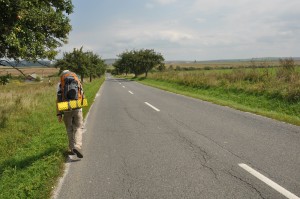
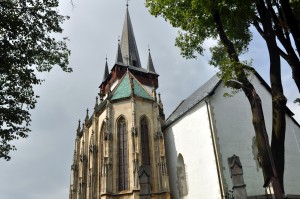
Apple trees lining the road to Spišský Štvrtok and also an ornate church in that village.
The walk to this second village, which sits at the cross-road of two major roads, was actually quite pleasant. It was made pleasant by a total overpopulation of apple trees lining the road. There was basically an apple tree every 20 feet and we snacked on apples all the way to the end. In the village we passed by an ornate church and found that the bus to be arriving in under two hours. Just outside the bus station was Penzion Stenly which happened to offer a lunch menu. Later, as we were sitting at the bus stop, a strange old man came up and started talking to me. His left hand was swollen to the size of a grapefruit and he had a nasty bloody gash across his palm. He started telling me, in a thick Spiš accent mixed with many years of drinking, that he got bitten by a dog. I told him that he should go see a doctor. He started telling me how he can’t because then the authorities will start investigating the dog’s vaccinations and it will cost a lot of money and so on. Before he stumbled off, he went on a rant about how government is building all these useless new highways which he doesn’t need since he doesn’t have a car.
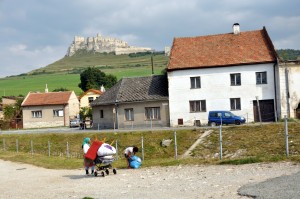
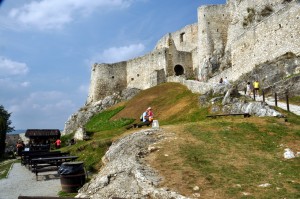
Gypsy town in the foothills of the Spiš Castle and the castle itself
The bus came 10 minutes late but we were happy to be finally on our way to the castle along one of those new highways. It’s quite easy to get to the castle from the bus stop as there are various signs indicating the way. The castle also forms a dominant backdrop. The path however passes through a rather seedy part of town, a gypsy “ghetto”, which may be bit of a turn off for tourists (there is also another way to get to the castle if you drive). In this gypsy part we passed by a woman bathing her naked child in the creek. The hike up to the castle is quite steep. Once in, we took a tour of the grounds. We learned a number of interesting tidbits from the tour guide. For instance, supposedly the royalty thought that bathing with the servant girls gave them STDs. As such, they came to the only possible logical conclusion: water must be bad and must be banned. All cooking and drinking was to be done with wine. The cooking in the medieval times was also different, scrambled eggs were for instance made with the shells and the eggs were first cooked in wine. Bread was used as plates and was later given to the servants to eat.
We also learned about the site’s history and geography. The castle dates back to the 12th century, however, previously the present location held an earlier Celtic establishment dating all the way to 1AD. The Slavs came in 6AD and built a wooden castle on the neighboring Dreveník peak. The castle contained several defense towers. In these, the staircases were oriented such that the attacker had to hold the sword in the left hand while the defender would use his right one, giving him some advantage (assuming he was right handed, which I guess was part of the job description). One of the towers collapsed in an earthquake. The last family to live here, the Csáky, left in 1760 since the castle was not up to their comfort standards. Soon after, the castle was destroyed in a fire. The actual reason is not known, but there are several theories. One is, the soldiers left behind to guard it were making pálenka (moonshine) and managed to burn it down by accident. Another theory is that the family burned the castle down on purpose to avoid having to pay taxes. In those days, you were taxed not by the square footage of the house but by the number of roofs. Roofs burned down = no tax to pay. Or possibly it was just struck by lightning. The red rocks that are prominent near the entrance get their color from iron deposits, which attract lightning.
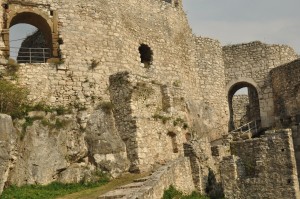
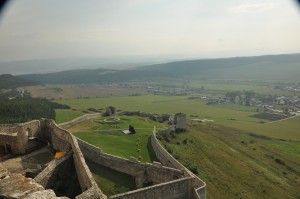
Inside the castle walls and a view to the country side, including a restored site of the earlier Celtic settlement.
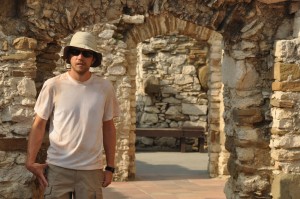
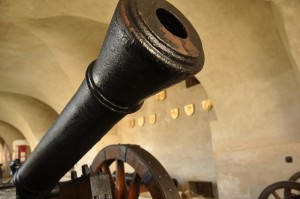
Alex and a cannon in the castle museum
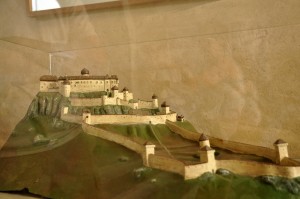
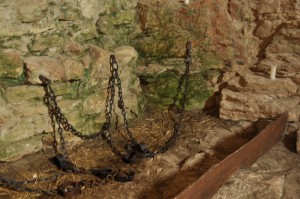
In the museum you will also find a mockup of how the castle used to look before burning down. It would be nice to get it restored to the original form, however this would require a massive financial investment. The second picture shows chains used to tie prisoners that you will pass on the way through the “torture chamber”.
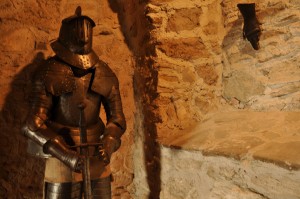
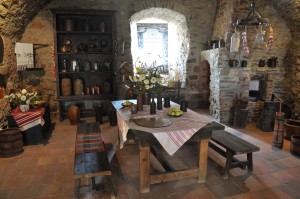
You will also pass by several medieval era body armors as well as a medieval kitchen. Given that I am into cooking, I really enjoyed this part.
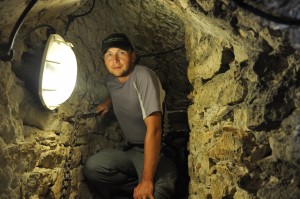
And here is just a picture of me in the defense tower staircase. Looking a bit chubby – must be all that tasty Slovak food!
Červený Kláštor (Red Monastery), August 30th, 2012
After our tour we walked back to town and caught a bus just as it was arriving that took us back to our base camp in Poprad: Hotel Tatra. We got the same room as last time, #501. I again inquired about my missing bivy but they had not found it – so I most likely left it on the bus. I also finally got a hold of my dad. He was planning on joining us on various parts of the trip but he has been getting busy with work. The next morning we grabbed breakfast in the completely empty breakfast room – much different than few days ago when it was full of Polish or Ukrainian tour groups. We then jumped on the bus first to Spišská Stará and then to Červený Kláštor, a village named after a červený kláštor (red monastery) that sits just outside the outskirts. Dad said he would try to join us here, but again, something came up. So Alex and I walked up to the monastery and took a tour. It was quite interesting, we learned about the legend of the flying monk Cyprian. Cyprian lived at the monastery until 1775 and was famous for his interest in science and medicine – he was a collector of healing herbs. According to the legend, he built a set of wings and flew from the towering Three Crowns peaks all the way to the High Tatras. There is now even a documentary about this legend, which conveniently was showing on TV just as we got back the following day to my dad’s house.
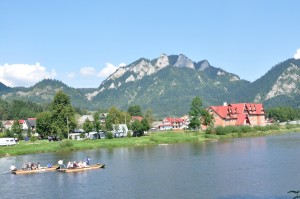
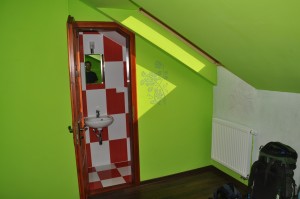
The Dunajec river which forms the border between Slovakia and Poland. That’s Poland across the river. The Polish village sits below the dominant Three Crowns (Tri Koruny) peaks. The second picture shows the brightly colored room in the penzion where we stayed.
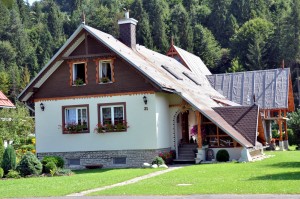
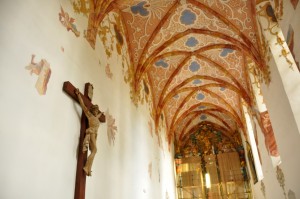
The village of Červený Kláštor is a great place to observe some amazing traditional architecture such as the house in the first picture. The second picture is from inside the Red Monastery.
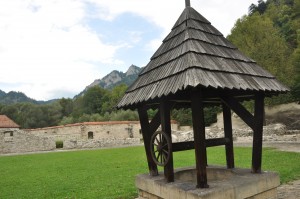
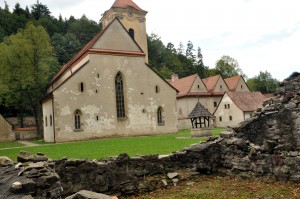
Photos of the monastery from the courtyard. You can see the Three Crowns in the first picture.
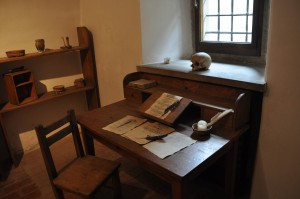
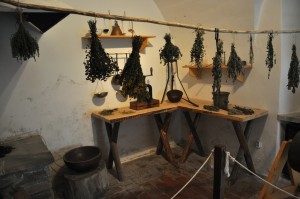
This is how the monks lived: this was their study and their kitchen.
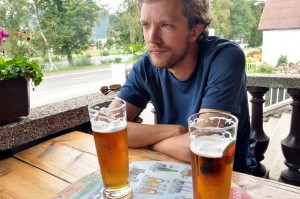
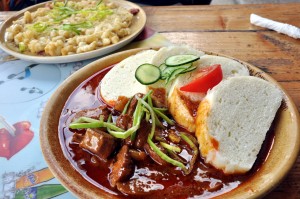
The food in Červený Kláštor was delicious. Here we are having strapačky and Maďarksý guláš (and pivo, of course!)
Pieniny National Park, August 31st
After lunch we found a penzión to spend the nigh (25 euro for both of us) and walked to one of the pltníci (rafters) companies to ask about getting on a raft. We decided to take a raft in the morning. We then crossed over to Poland and started hiking up the Three Crowns. A weird thing we noticed in Poland was that many houses were lacking plaster or paint – they had just the exposed bricks or cinder blocks (houses in Slovakia and Poland are built from bricks and not from wooden sticks as is common in the US). We later found out that a house is not considered to be complete until it is painted and hence the owners do not need to pay property taxes if they don’t paint the house. We didn’t make it all the way to the top since we had a late start. Back in Slovakia, we grabbed dinner of pizza and palacinky but also managed to finish the rest of our hiking food. Alex cooked soup on the penzion balcony and I ate the last of my rice cakes and Nugetta. The next morning we dropped off the keys on the way out – the reception was still closed – and got on the rafts. The rafts cost 10 euro per person. There were 13 of us on board. Supposedly the limit is 12 but a raft with 17 went down earlier and didn’t get stuck, as we were reassured by the rafter.
Rafting down the Dunajec river is a really nice way to enjoy the Slovak countryside. This is a trip you should definitely try to take on your own visit to Slovakia. The rafts consist of multiple kayak-like skinny wooden rafts joined together. Although there are few rapids along the way, these are very minimal, basically just little bumps breaking up the otherwise smooth relaxing ride down the river gorge. But if you go, make sure to learn some Slovak or at least bring along somebody who speaks the language. Otherwise, you will miss out on all the mother in law jokes our rafter kept throwing at us. The raft trip is one way only. I believe there are buses you can take back, or you can rent a bicycle to ride a nice path along the river. We didn’t do either and simply walked. Back in town, we got back on the bus that eventually took us back to Banská Bystrica, and the end of our hiking journey across Slovakia.
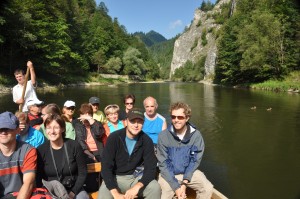
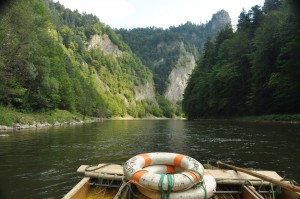
Here we are on the raft. That’s me and Alex in the first row. The views are quite spectacular.
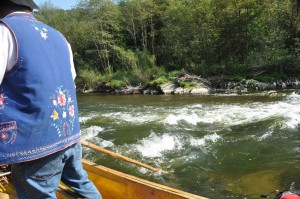
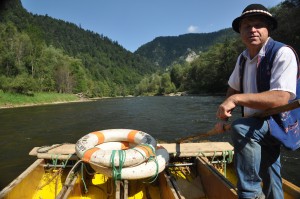
Our head rafter in the traditional costume navigating one of the “rapids” along the way.
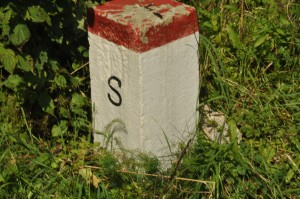
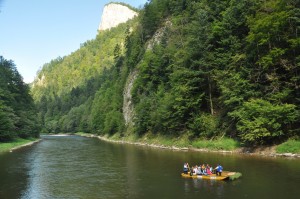
The hike back follows the river, which forms the border between Poland and Slovakia.
This was the end of my trekking with Alex. But it was only the first half of my European trip. Read on for the rest of my Eurotrip’11.
YOu make me proud that my Baba and Dzedou [sp] came from Slovakia. I love the scenery and history. The food was always a big deal growing up but I never knew there was so much to the “old country”.
Thanks Florine!
hi Lubos, good for you and good for Slovakia with you promoting it.
Things got better in Slovakia, they did pretty good job at restoring Spisky Hrad (I don’t see a need to restore it to it’s original shape) and folks at Pieniny rafting has improved as well (at least from a safety point of view) some 40 years ago they still did it but using just real old fashioned wooden logs raft.
As far as gypsies ghetto goes, it also moved way far for better, them houses look quite well maintained. I remember driving through a gypsy village close to Detva in central Slovakia some 10 years ago, quite different, totally destroyed, trash everywhere, but those were a typical “project houses”, a three stories apartments. This gypsy village under Spissky Hrad looks pretty good.
Just my opinion.
Good to hear that Miro. Thanks!
Oh, I enjoyed this because it brought back memories of my 2010 trip there with Treasure Tours where I saw and did these things. What a beautiful country and what a wonderful trip. I do not drink beer but did in Slovakia and man, was it good!
Thanks Eva. That must had been a fun trip. I had a chance to meet Helene. It was in Piestany in the winter of 2009-2010, she was there throwing a party for her mom’s 90th birthday. I’ve since met up with her few times at various festivals here in the US.
Love your photos and stories. Makes me wish I could see all of this. Keep posting, I really enjoy you posting.